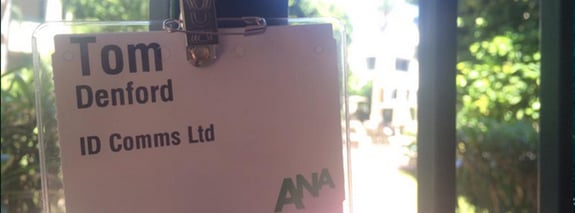In the context of continued rumblings in U.S. over media rebates and advertiser demands for greater transparency in media, I headed to Phoenix, Arizona to hang out in the dessert sunshine with 700 marketing procurement leaders. We are attending the Association of National Advertisers (ANA) conference called "Advertising Financial Management" which you can pick up on Twitter using#ANAAFM.
The ANA, if you don't know is the leading U.S. marketing trade body, representing the marketers interests and this conference provides a strong opportunity for marketing procurement to meet to discuss key issues, share and learn best practice and network.
You may have followed the developing trade press news stories, commentary andanalyst reporting which has been shining a light on potential unsavory financial practice by media agencies, there has been a lot of accusation flying around and agencies in the recent Q1 results reporting took opportunity to push back on the accusers. This meant that the AFM conference came at an opportune time for procurement leaders to challenge their agencies on media transparency and find aligned interests to resolve the confusion.
This was my second AFM, I went to last year's and was a little disappointed with the agenda which was very light on media discussion; they had a panel discussion in the final 40 minutes of the three day conference to debate media transparency concerns. It was not enough.
I was delighted to find that in the last 12 months, media (transparency) had become the primary agenda item for this year's conference and it started with gusto, the first session was boldly called "Transparency TownHall" and ANA's Bob Liodice andBill Duggan launched off this provocative debate by announcing a much needed'ANA Task Force' to find alignment between client needs and agency behaviours.
Bob Liodice stated "it's ANA's opinion that rebates do exist in the U.S. to some extent" at which is was turned over to the attending client side audience to discuss the topic and question agencies. Most client speakers admitted they hadn't yet been given required transparency from their agencies, but also conceded they didn't necessarily have the right resources to adequately challenge agencies. There was consensus that brands should seek to have a contractual relationship with the media trading group level (as we've been saying for some time now) rather than the agency because that's where the most financial benefits will exist and clients will want to hold the agency at group level to account for contract compliance to ensure they get the full value of their media spend and any additional benefits negotiated.
Bob warned that significant value could be being left on the table, ANA's estimate is $10 billion....just in the US.
David Dobbins, Media Director Sourcing from pharma giant Boehringer Ingelheim was first up to share their recent experiences on negotiating with global media agencies. He gave some examples of potential "rebate" practice and ways there could be financial relationships between media vendors and media agencies that could fall outside the scope of the traditional media audit. He reminded other clients that this was potentially a risk to media value delivery in most parts of the world.
Darren Wooley, of Australian marketing consultant TrinityP3 made a very good point that clients need to be careful not to confuse media price benchmarking with financial audits. The two things are not the same and clients should not assume that because they use "auditors" to benchmark their pricing that they are getting transparency on agency financial practice, a good watch out.
Keri Smith from legal advisers ReedSmith called upon agency CFOs to provide to their clients "certification of no media rebates or AVB's" (I've highlighted below in yellow) which seems like sensible advice, whether or not agencies will be willing to provide such assurance.
The TownHall approach continued with the microphone being open to the floor,Ana Jernestaal, AVP Finance at L'Oreal US making the most notable comment. She challenged agencies present to speak up, stating that L'Oréal was becoming aware of rebate practice in U.S. but she said that agencies they had spoken to were flatly denying their existence. Ana also asked if any clients present had engaged their agencies in frank rebate discussions, no hands were raised. L'Oreal are currently pitching their $2bn media account in U.S. at present so they are in a good position to leverage that scale to demand greater transparency in these issues and also implement a contract at the holding company level of whichever agency they ultimately choose. The U.S. industry will be watching L'Oreal closely to see what progress they can achieve in this timely pitch, likely to be one of the biggest of 2015.
This was a strong start to the AFM conference, it was great to see media being front and centre of a procurement conference agenda which historically had put media issues far down on the billing. Last year's media discussions were limited to a poorly attended panel discussion in the graveyard slot at the end of the conference when many people had already checked out and headed to the airport. This year, it was clear that the ANA meant business and wanted everyone to see how seriously they were taking media transparency issues and to build consensus behind their task force announcement.
Day Two
The second day launched with two great presentations, the first from Bob Liodice, President of ANA who predicted that marketers were "leaving $10bn of value of the table" through lack of transparency, especially in regard to the digital media supply chain and click fraud.
This was followed by Peter Stabler, Senior Analyst at Wells Fargo. Peter follows the advertising sector closely in his role advising investors and he gave delegates a great summary of "The Wall Street Perspective" of our insular industry which opened minds and highlighted the relative financial performances of the big marketing service holding companies who have all outperformed the market and global GDP growth, largely by acquisition which is a theme Peter expects to continue. He flagged a word of caution over the complexities of new digital trading methods.
Other notable highlights of Day Two included discussion on recent ANA research into the quality of the Client / Agency relationship, the key slide indicates that there is a delta between the quality of brief the client thinks they are writing and what the agencies feel about the brief.
Eve Reiter, VP Global Supply Management at American Express was up next. Eve shared example of AmEx best practice in agency management, values that we here at ID Comms fully endorse; including the need to invest in both thinking and money to maximize agency relationships. Her tips included the importance of two way client/agency evaluations and the value they provide in enabling clients to link agency income to meaningful results.
The traditional post-lunch afternoon lull was nowhere to be seen when Joanna O’Connell from AdExchanger took the stage with a rallying cry to marketing and procurement leaders to embrace programmatic media buying. Joanna is one of the industry’s most articulate speakers on this subject and worth hunting out, including her previous work at Forrester where she co-published a must read white paper with ANA on Agency Trading Desks in 2011.
Steve Lightfoot from the World Federation of Advertisers closed Day Two with a snapshot of recent WFA research into marketing procurement structures. His main challenge to the audience was for them to organise themselves into "a marketing procurement model with the emphasis on marketing” to ensure that procurement effectively supported marketing ambition and minimised the conflict or tension which can cause marketing processes to breakdown. He also revealed his "Marketing Procurement Astrology" chart and offered delegates private Tarot readings over cocktails to determine their fates.
Day Three - Irwin Arrives
Day three saw the much anticipated appearance of GroupM’s global Chairman, media veteran Irwin Gotlieb. Given the recent furore over media trading practice I think many delegates would not have been surprised if Irwin had found an urgent matter that would keep him safely in New York, so it was credit that he made the trip to Phoenix under the glare of the spotlight. His 40 minute “fireside”format interview with Bob Liodice had the feel of a well prepared (and counsel advised) series of statements. At times, Irwin was taking very long pauses before responding to Bob’s questioning.
Overall, he equipped himself well given the awkward tensions in the room. He acknowledged some mistakes had been made in the past by agencies “I think in the past we’ve stepped on each other a little bit, we’ve extracted results for ourselves on the back of someone else’s activity” and called on clients and agencies to work together to resolve this. He suggested that clients were often lacking in understanding about media (which is a cheap shot really) and he implied that this made them somewhat complicit in the current situation where trust in media agencies has been on the decline.
His solution to the current issues of transparency and trust, highlighted in the quote above, was that clients need to get way smarter at building contracts to that they can use to hold agencies to proper account, ID Comms strongly advocates investing in best practice media agency contracts . The contract a brand has with a media agency is the fundamental to the quality of the relationship and the value delivery you can expect from the agency. The agency contract should clearly define the role and scope of the agency and the standards to which they should be held. Irwin's comment that in the past some contracts have not properly aligned the media agency to the client goals is a fair point, but its puts the blame on the client's shoulders. Either way, all clients should seek out best practice contracts and be making sure that the agency (and their holding / trading company) is directed and incentivized to work 100% in the interests of the client to achieve their goals.
The underlying theme to Irwin's chat with Bob was an acknowledgement that trust between client and agency had been negatively affected by behaviors on both sides in recent years. Looking forward both sides, exemplified by the ANA Media Transparency task force, need to make commitments and efforts to work together to repair that trust and build stronger, collaborative relationships around aligned interests.
Irwin left the stage bang on time and it was disappointing he was not comfortable or confident enough to accept any questions from the audience, many of whom represent major global clients for his business, this meant it all felt rather stage managed and one-way but better to have him there and hear their point of view than not.
Later that morning, Doug Wood, partner at lawyers ReedSmith (who work for both clients and agencies by the way) gave an explosive presentation which suddenly pulled into acute focus the importance of procurement clients having a point of view in critical areas of potential value loss; including AVBs and rebates, Programmatic buying, Digital Fraud and Data Security. Doug’s biggest message, echoing Irwin’s prior comments was that the legal role of the media agency as ‘agent’ (rather than principal) to buying contracts has become blurred, something which the law tends not to like very much. He brilliantly articulated (with help from his friend Francis the cat) the necessary watchouts for procurement, of which the most important centered around not assuming transparency concerns are just limited to digital channels and that the “system runs on too much trust”.
Day Three
On the final day, we started with an inspirational innovation keynote from author and provocateur Joseph Jaffe who had a strong message for procurement to get out of the way of their company’s innovation. He means that in the best way possible, challenging procurement that sometimes their sourcing frameworks and financial policies (e.g. extended payments terms) is actually hindering innovation because this can prevent large companies working with innovative small ones. Hechallenges procurement to be able to bend the rules sometimes and show behaviours more commonly found in disruptive businesses like Uber. Jaffe is a prominent advocate of 70/20/10 (now, new, next) innovation framework used by many large marketing organisations. He ended with a rallying cry with procurement to focus on value creation and how they can support their company’s innovation agenda which in some businesses requires a recalibration of procurement practice.
The conference ended with gusto with an energetic session by ex Microsoft executive Bruno Gralpois who shared an enthusiastic manifesto of 10 top agency management trends. His focus was on championing better agency management practice and “motivating agency resources with more than just a chequebook (money)” by championing and rewarding good work.
Next year the conference will take place in Boca Raton, Florida 1-4 May 2016 and I hope that momentum created this year especially in tackling some of the big media issues continues. It was great to see procurement leaders engaging with media issues properly, probably driven by the fact that media is raising profile in the marketing mix and recent concerns over agency financial practice. We look forward to the ANA Task Force results shortly and will be reporting back with our assessment of their progress.
Executive Summary
- Majority of talk was focused on media (which is great), it is no longer “the boring bit which gets left to the end”
- There seemed to be more consensus amongst procurement clients that their focus should be on value creation not cost cutting. It was encouraging to hear this language frequently through the 3 days and marks a cornerstone in marketing procurement evolution
- The escalating conflict that appeared to be brewing between suspicious clients, accusation-based press coverage and defensive agencies over the US media rebates issue was calmed slightly and conversation on both sides, whilst not conclusive, was more constructive and pragmatic than ever, good progress
- GroupM’s Irwin Gotlieb made some waves by questioning whether media agencies should be considered ‘agents’ any longer given the levels of risk they are taking on the back of client demands for guarantees. He admits some previous bad behaviours by agencies have occurred but encourages both sides to find alignment
- The ANA task force into media trading transparency has great potential to resolve this further and the industry will be keenly watching how they make progress in the coming months
- The ANA also took the opportunity to promote their excellence white paper on"Enhancing Client / Agency relationships" - you can get a free snippet here, whole report available to ANA Members
- The industry made some progress in these few short days and I expect that procurement leaders headed back to their desks after the conference with a renewed focus of purpose, ambitions to better support marketing objectives and empowered with new ways of challenging their agenciesfor performance improvements, focusing on value creation rather than cost savings.





COMMENTS